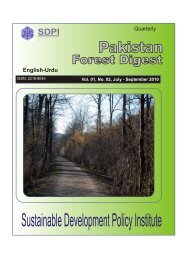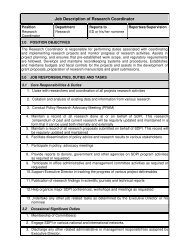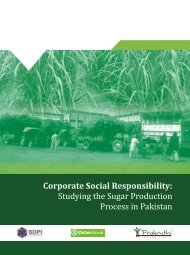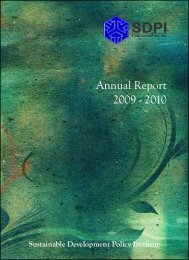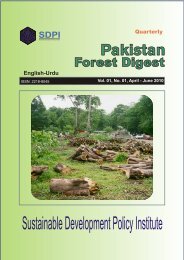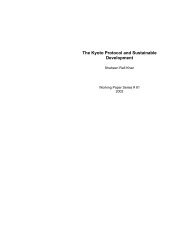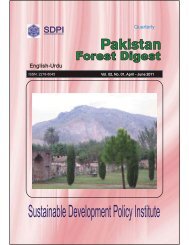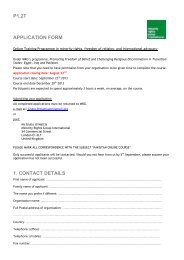Attitude of Female Teachers towards Religious Minorities: A Case ...
Attitude of Female Teachers towards Religious Minorities: A Case ...
Attitude of Female Teachers towards Religious Minorities: A Case ...
- No tags were found...
You also want an ePaper? Increase the reach of your titles
YUMPU automatically turns print PDFs into web optimized ePapers that Google loves.
<strong>Attitude</strong> <strong>of</strong> <strong>Female</strong> <strong>Teachers</strong> <strong>towards</strong> <strong>Religious</strong> <strong>Minorities</strong>:A <strong>Case</strong> Study <strong>of</strong> KPK <strong>Female</strong> MadrassasAfsheen NazWorking Paper no: 123Sustainable Development Policy Institute, Islamabad, Pakistan
All rights reserved. No part <strong>of</strong> this Policy Paper may be reproduced or transmitted in any form orby any means, electronic or mechanical, including photocopying, recording or informationstorage and retrieval system, without prior written permission <strong>of</strong> the publisher.A publication <strong>of</strong> the Sustainable Development Policy Institute (SDPI).The opinions expressed in the paper are solely those <strong>of</strong> the author, and publishing them does notin any way constitute an endorsement <strong>of</strong> the opinion by the SDPI.Sustainable Development Policy Institute is an independent, non-pr<strong>of</strong>it research institute onsustainable development.© 2011 by the Sustainable Development Policy InstituteEdited by: Ayesha SalmanFirst Edition: July 2012Mailing Address: PO Box 2342, Islamabad, Pakistan.Telephone + (92-51) 2278134, 2278136, 2277146, 2270674-76Fax + (92-51) 2278135, URL: www.sdpi.org
Table <strong>of</strong> Contents1- Introduction ------------------------------------------------------------------------------------------------- 12- Context <strong>of</strong> the Study --------------------------------------------------------------------------------------- 22.1- Madrassa Education ............................................................................................................ 22.2- <strong>Religious</strong> <strong>Minorities</strong> in Pakistan ......................................................................................... 42.3- <strong>Female</strong> Madrassa <strong>Teachers</strong> and <strong>Minorities</strong> ........................................................................ 53- Objectives <strong>of</strong> the Study------------------------------------------------------------------------------------ 64- Methodology and Data Set ------------------------------------------------------------------------------- 75- Analysis ----------------------------------------------------------------------------------------------------- 86- Conclusion ------------------------------------------------------------------------------------------------- 14References ----------------------------------------------------------------------------------------------------- 15Annexure: ------------------------------------------------------------------------------------------------------ 16
1- IntroductionPakistani society comprises people belonging to different cultures, religions and ethnicbackgrounds. Ninety five percent <strong>of</strong> the population is Muslim while the other five percentbelongs to other religions, — these are known as religious minorities. 1Irrespective <strong>of</strong> religious identity every person living in Pakistan has equal constitutionalrights. Conversely, the dominating majority at times takes advantage <strong>of</strong> religious minoritygroups, violating the law and resulting in disregarding the rights <strong>of</strong> minorities. Severalstudies have been carried out to find out what is behind such behavior and suggest a largenumber <strong>of</strong> social, economic, cultural, political and historical factors. At the heart <strong>of</strong> all thesefactors lies the education system which serves as a means to reinforce the discriminatoryattitudes <strong>of</strong> the majority (Nayyar and Saleem 2003).In Pakistan, there are three major types <strong>of</strong> educational systems, (i) public schools (ii) privateschools and (iii) the madrassa 2 education system. The public education system hasextensively been studied to find out the ways in which education promotes biases anddiscriminating attitudes based on religious identities – through textbooks and teachingpractices. However, far less attention is paid to understand the ways in which madrassaeducation plays its role in shaping the attitudes <strong>of</strong> students <strong>towards</strong> religious diversity.Within the madrassa education, there is a dearth <strong>of</strong> literature on the dynamics <strong>of</strong> femalemadrassas particularly related to the role that textbooks and teachers play in influencing thebehaviour <strong>of</strong> female students <strong>towards</strong> various religious identities. This paper, in this context,is an attempt to explore the attitudes <strong>of</strong> female madrassa teachers <strong>towards</strong> the followers <strong>of</strong>different minority religions in the broad sense as well as within the madrassa educationsystem. The paper is based on SDPI’s recent report on education and religiousdiscrimination, titled, “Connecting the Dots: Education and <strong>Religious</strong> Discrimination inPakistan, a Study <strong>of</strong> Public Schools and Madrassas”. The report explored prejudices againstpeople <strong>of</strong> other religions in both educational systems; public schools and madrassas. Despitebeing a comprehensive study on the subject, this report did not provide any insights into theattitudes <strong>of</strong> female madrassa teachers and instead focused on male madrassa teachers only.This paper is based on qualitative data collected from Khyber Pakhtoonkwa (KPK) provincethrough focus group discussions <strong>of</strong> female madrassa teachers. The analysis <strong>of</strong> the dataprovides a mix <strong>of</strong> responses showing the coexistence <strong>of</strong> biases alongside tolerant attitudes<strong>towards</strong> religious diversity.1 Pakistan country pr<strong>of</strong>ile 20112 <strong>Religious</strong> seminaries, privately run by religious organizations1
2- Context <strong>of</strong> the Study2.1- Madrassa Education2.1.1. MadrassaA Madrassa is known to be an Islamic religious institution where religion and differentreligious practices are taught. However, these religious institutions vary in their natureand school <strong>of</strong> thought hence forming various types. In Pakistan there are three majortypes <strong>of</strong> religious institutions3;1. Quranic Schools: These are schools where only the Quran is taught.2. Mosques Schools: These are schools where both Quranic and secular subjectsare taught.3. Madrassas: In these schools, generally, Islamic learning takes place.Madrassas work to inculcate religious knowledge in students to preparereligious scholars.2.1.2. Evolution <strong>of</strong> Madrassas in the Subcontinent and PakistanUzma Anzar (2003) in her study presented the ideological shift in the teachings <strong>of</strong>madrassas <strong>of</strong> the Indian subcontinent. Historically, in the subcontinent, the madrassaswent through a radical shift in ideology during the British rule. The purpose <strong>of</strong> such aformation was to protect and preserve Islamic teachings to counter the domination <strong>of</strong> theBritish English schooling system. In 1867, the first madrassa, the Deoband school <strong>of</strong>thought was established in the subcontinent. 4 At the time <strong>of</strong> the creation <strong>of</strong> Pakistan,madrassas were not in monolithic number, as a total <strong>of</strong> 189 madrassas were reported toexist at that time. 5 The number <strong>of</strong> madrassas did not grow rapidly as less than 2,000madrassas were known to exist in Pakistan in 1979. 6 A mushroom growth <strong>of</strong> madrassasin Pakistan began after 1980s. According to a report by the Human Rights Commission<strong>of</strong> Pakistan (HRCP 2002), the number <strong>of</strong> madrassas increased drastically, reaching28,000 in 2002. Out <strong>of</strong> these, only 8,000 madrassas are <strong>of</strong>ficially registered (Ibid.).Suba Chandran, in his study “Madrassas in Pakistan” (2003), highlighted the facts behindsuch rapid growth <strong>of</strong> madrassas in the country. According to his study, such growth in thenumber <strong>of</strong> madrassas was commonly attributed to General Zia-ul-Haq’s Islamizationpolicies. Nonetheless, according to him, there were other internal and external factorswhich contributed to the rising number <strong>of</strong> madrassas in Pakistan. Chandran, looks at this3 Islamic education a brief history <strong>of</strong> madrassas with comments on curricula and current pedagogical practices,UzmaAnzar, 20034 Mumtaz Ahmad, “Madrassa Education in Pakistan and Bangladesh”5 http://centralasiaonline.com/cocoon/caii/xhtml/en_GB/features/caii/features/pakistan/main/2011/01/29/feature-016 “Madrassas in Pakistan” Subachandran, 20032
issue by dividing madrassas geographically into two categories, (i) KPK &Balochistanand (ii) Punjab & Sindh.The involvement <strong>of</strong> Pakistan in the Afghanistan war in 1980 is considered to have largelycontribute to the growth <strong>of</strong> madrassas KPK and Baluchistan. The heavy influx <strong>of</strong> Afghanwar refugees in Pakistan, according to Chandran, was used as a war tool by theGovernment <strong>of</strong> Pakistan, supported by the Government <strong>of</strong> United States <strong>of</strong> America.Madrassas in KPK and Balochistan were used to prepare these Afghan migrants to fightas mujahedin. The financial support for this purpose facilitated the establishment <strong>of</strong> alarge number <strong>of</strong> new madrassas.The Khomeini Revolution in Iran in 1980, according to Chandran, changed the numbersand nature <strong>of</strong> madrassas situated in Punjab and Sindh. The revolution resulted in splittingup the whole Muslim Umma into Sunni and Shia sects. Consequently, madrassas werefound to be involved in sectarian extremism in both provinces.2.1.3. Structure/Composition <strong>of</strong> Madrassa Education in PakistanIn Pakistan, five types <strong>of</strong> madrassas function on the lines <strong>of</strong> five major religious sectshaving their own curricula: Tanzim-ul-Madaras (Barelvi), Wafaq-ul-Madaras(Deobandi), Wafaq-ul-Madaras (Shia), Wafaq-ul-Madaras (Ahle Hadith) and Rabita-ul-Madaris (Jamaat-e-Islami). 7 However, all these five boards come under an educationalboard “Ittehad Tanzeemul Madaris”. 8 The contents <strong>of</strong> the curricula being used in thesemadaris are, reportedly, centuries old with no major changes over the period <strong>of</strong> time. Theoverall objective <strong>of</strong> all madrassa curricula is to nurture and prepare students to becomereligious scholars.Central Boards <strong>of</strong> Madrassas in PakistanName Sub-Sect Place Date EstablishedWafaqulMadaris Deobandi Multan 1959TanzimulMadaris Barelvi Lahore 1960Rabta-tul-Madarisal-IslamiaJamaat-i-Islami Lahore 1983Wafq-ul-Madaris-al- Ahl-i-Hadith Faislabad 1955SalafiaWafaqulMadans Shia Lahore 1995(Shia) PakistanSource: “madrassas: religion, poverty and the potential for violence in Pakistan” Tariq RahmanUnder all religious sects there are a total 12,448 deeni madaris in Pakistan, <strong>of</strong> which 363(3%) are in the public sector while 12,085 (97%) are in the private sector according toPakistan Education Statistics 2007-08. Whilst, the total enrollment in the Deeni Madaris7 Central Asia Online(http://centralasiaonline.com/cocoon/caii/xhtml/en_GB/features/caii/features/pakistan/main/2011/01/29/feature-01)8 Islam Online (http://www.islamonline.net/en/IOLArticle_C/1278408868340/1278406720653/IOLArticle_C)3
is 1.603 million <strong>of</strong> which 0.454 million (3%) is in public sector, whereas, 1.558 million(97%) is in private sector. However out <strong>of</strong> total enrollment the male students are higher(62%) as compared to female students (38%). Whereas, a total 55,680 teachers arerecruited in these madaris <strong>of</strong> which 77% are male while 23% are female teachers. 9Madrassa education is mostly provided free <strong>of</strong> any cost in Pakistan. However, there arecertain internal and external sources that bear the administrative, boarding and lodgingcost <strong>of</strong> madrassas. Mumtaz Ahmad in his study “Madrassa Education in Pakistan andBangladesh” identifies many <strong>of</strong> the internal and external funding sources for madrassas,for instance, trusts, endowments, charitable donations, and zakat contributions are some<strong>of</strong> the internal funding sources, besides, money from emigrant workers and wealthier andinternational Muslim non-governmental organizations (NGOs) come under externalfunding sources.Madrassa education is far different than the public school education in Pakistan because<strong>of</strong> the difference <strong>of</strong> curricula being used in both systems as emphasis <strong>of</strong> the madrassacurricula is on Islamic teachings while secular education is <strong>of</strong> low importance. Over theperiod <strong>of</strong> time many reforms have taken place in madrassas. The madrassa reform <strong>of</strong> thepassing <strong>of</strong> “Deeni Madaris (Voluntary Registration and Regulation) Ordinance 2002” inGeneral Parvez Musharaf’s regime is one <strong>of</strong> the current reforms (Chandran 2003). Underthis ordinance, the permission <strong>of</strong> the concerned districts is obligatory for setting up anynew madrassa. Also madrassas were forbidden to preach sectarianism and militancy andhatred, however the ordinance was allowed to be implemented at a larger scale bymadrassa administrative bodies. 102.2- <strong>Religious</strong> <strong>Minorities</strong> in PakistanPakistan is an Islamic state in which 95 percent <strong>of</strong> the population comprises <strong>of</strong> Muslims,(seventy five percent <strong>of</strong> Sunni and twenty percent Shia). 11 The total number <strong>of</strong> people belongingto other religions in Pakistan is five percent <strong>of</strong> the entire population. These are Christians,Hindus, Parsis, Sikhs, Bahais, Ahmadis and other castes.Although the constitution <strong>of</strong> Pakistan ensures rights to non-Muslims living in Pakistan, theserights are rarely recognized. This lack <strong>of</strong> realization results in discriminatory behavior against thepeople <strong>of</strong> other religions over a period <strong>of</strong> time. Recently, the incident <strong>of</strong> the murder <strong>of</strong> FederalMinister <strong>of</strong> <strong>Minorities</strong>, Mr. Shahbaz Bhatti, in the backdrop <strong>of</strong> his remarks about the blasphemylaw, is an example <strong>of</strong> the continuation <strong>of</strong> such prejudice. The Constitution <strong>of</strong> Pakistan clearlystates the rights <strong>of</strong> religious minority groups in several articles as shown below.The rights <strong>of</strong> religious minorities in Constitution <strong>of</strong> Pakistan 1973 (selected articles) 129 Data on Deeni Madaris Institutions, <strong>Teachers</strong> and Enrollment by central boards, Province and Gender has beenprovided in the annexure.10 Pakistan: Madrasas, Extremism and the Military ICG Asia Report No.36, 29 July 200211 Ibid, page 0112 Constitution <strong>of</strong> Pakistan 1973 (http://pakistanconstitution-law.org)4
Article 20: Freedom to Pr<strong>of</strong>ess Religion and to Manage <strong>Religious</strong> Institutions20. Freedom to pr<strong>of</strong>ess religion and to manage religious institutions. – Subject to law, publicorder and morality;(a) Every citizen shall have the right to pr<strong>of</strong>ess, practice and propagate his religion; and(b) Every religious denomination and every sect there<strong>of</strong> shall have the right to establish,maintain and manage its religious institutions.Article 22: Safeguards as to educational institutions in respect <strong>of</strong> religion, etc;(1) No person attending any educational institution shall be required to receive religiousinstruction, or take part in any religious ceremony, or attend religious worship, if suchinstruction, ceremony or worship relates to a religion other than his own……Unfortunately, although the constitution gives many rights to minority groups to freely practiceone’s own belief there are also a number <strong>of</strong> articles that create discrimination between religiousminorities and the majority. Below are some examples <strong>of</strong> such articles which are equallyapplicable to all people living in Pakistan with no exception to religious minorities. For instance;Article 31: Islamic Way <strong>of</strong> Life(1) Steps shall be taken to enable the Muslims <strong>of</strong> Pakistan, individually and collectively, to ordertheir lives in accordance with the fundamental principles and basic concepts <strong>of</strong> Islam and toprovide facilities whereby they may be enabled to understand the meaning <strong>of</strong> life according tothe Holy Quran and Sunnah.(2) The state shall endeavour, as respects the Muslims <strong>of</strong> Pakistan;(a) To make the teaching <strong>of</strong> the Holy Quran and Islamiat compulsory, to encourage andfacilitate the learning <strong>of</strong> Arabic language and to secure correct and exact printing andpublishing <strong>of</strong> the Holy Quran;(b) To promote unity and the observance <strong>of</strong> the Islamic moral standards; and(c) To secure the proper organisation <strong>of</strong> zakat, [ushr,] auqaf and mosques”2.3- <strong>Female</strong> Madrassa <strong>Teachers</strong> and <strong>Minorities</strong>According to latest available data source <strong>of</strong> “Pakistan education statistics 2007-08”, there are atotal <strong>of</strong> 55,680 teachers in madrassas, <strong>of</strong> which 23% are female teachers educating 0.604 millionfemale students. One point is noteworthy at this stage that in most Pakistani madrassas femaleteachers are recruited for female students.5
Several studies have highlighted the curricula and pedagogical methods being used in publicschools in creating and promoting discriminatory behaviors against religious minorities.However, the attitudes <strong>of</strong> madrassa teachers, particularly female teachers remains the leaststudied area. Given the centrality <strong>of</strong> female madrassa teachers in influencing the attitudes <strong>of</strong>female madrassa students, this paper has focused on the attitudes and behaviors <strong>of</strong> femalemadrassa teachers <strong>towards</strong> non Muslim students in Pakistan.This study is aimed at finding out:3- Objectives <strong>of</strong> the Studya. The attitudes <strong>of</strong> female madrassa teachers <strong>towards</strong> non-Muslims in everyday life andsocial interaction with them;b. The justifications provided by the teachers for their attitudes <strong>towards</strong> non Muslims;andc. To identify ways <strong>of</strong> addressing the possible biased attitudes <strong>of</strong> the teachers.6
4- Methodology and Data SetIn order to have in-depth views <strong>of</strong> the teachers on the topic, Focus Group Discussions (FGDs)were conducted. This method has been chosen for the current paper, keeping in view itspr<strong>of</strong>ound effectiveness in stimulating the participants to reveal their opinions, attitudes andbehaviors <strong>towards</strong> non Muslims and motivations behind these. To grasp the actual point <strong>of</strong> view<strong>of</strong> the teachers that can best fit into the objectives <strong>of</strong> the study, check lists and discussionguidelines were also developed for the moderators. The responses <strong>of</strong> the teachers were recordedin audio-recorders and notes were taken. The audio records were later transcribed into English.A total <strong>of</strong> three FGDs were conducted at a local female madrassa in Abbotabad in the KhyberPakhtoon Khawa (KPK) province. Thirty three female madrassas teachers participated in theseFGD sessions. The participants were <strong>of</strong> different ages and had different years <strong>of</strong> teachingexperience in the madrassas located in three districts- Abbottabad, Mansehra and Haripur <strong>of</strong>KPK.7
5- AnalysisIn order to conduct a comprehensive analysis <strong>of</strong> the data, systematically, the responses <strong>of</strong> theteachers were divided into various themes. Keeping in view the objectives <strong>of</strong> the current paper,the data related to the following themes is analysed;1. Importance <strong>of</strong> madrassa education2. Knowledge about other religions and existence <strong>of</strong> religious minorities3. Interaction with minorities4. Equality <strong>of</strong> rights5. Reaction <strong>towards</strong> insulting behavior5.1. Importance <strong>of</strong> Madrassa EducationWhen teachers were asked about the importance <strong>of</strong> madrassa education, almost all <strong>of</strong> them were<strong>of</strong> the view that madrassa education plays a key role in keeping Muslims on the right path.According to their view, madrassa education helps students to act upon the teachings <strong>of</strong> Islamwhich ultimately turns their lifestyle into an Islamic way <strong>of</strong> living. Most <strong>of</strong> the participants were<strong>of</strong> the view that;“Madrassa education is very important as knowledge about religion and religious practicesincreases”,“The religion (Islam) is taught in-depth in madrassas. Moreover, what is also taught in themadrassas is how to act upon what is taught”Despite highlighting the factors behind the importance <strong>of</strong> madraassa education, a group <strong>of</strong>teachers further added a concept that relates to the character building <strong>of</strong> the students. This group<strong>of</strong> teachers was <strong>of</strong> the view that “through madrassa education, one can differentiate betweengood and bad”. Although this group indirectly highlighted this fact, the majority <strong>of</strong> theparticipants directly highlighted the aspect <strong>of</strong> madrassa education and characterized theirstudents as less inclined <strong>towards</strong> any crime. Many <strong>of</strong> the teachers, for example, said; “amadrassa student will never be inclined <strong>towards</strong> crime no matter how many hard times shefaced.”<strong>Teachers</strong> were also probed about the comparison and importance <strong>of</strong> secular education. In theirresponses the importance <strong>of</strong> acquiring both types <strong>of</strong> education was highlighted. Adding to theirresponse teachers said that madrassa education alone does not provide a financially attractivelivelihood to students hence keeping them and their families away from economic progress.<strong>Teachers</strong> were <strong>of</strong> the view that “combining both education systems into a comprehensive onewill make a good student”.8
Moreover, female teachers differentiated the provision <strong>of</strong> both kinds <strong>of</strong> education for girls andboys. They said, “to have secular education is more important for male students as they have toplay the role <strong>of</strong> the main earner for the whole family”.However, despite the fact that teachers were favouring acquiring modern education for economicgains, they preferred madrassa education as for them it provided an ethical way <strong>of</strong> living, anIslamic way <strong>of</strong> life;“Priority should be given to Islamic teachings while contemporary knowledge has a secondaryplace”Apart from highlighting the facts behind the importance <strong>of</strong> madrassa education, when teacherswere further probed about the reasons behind getting admission into madrassas, almost all <strong>of</strong> theteachers linked admissions to an attractive environment <strong>of</strong> madrassas. For example they said;“The environment <strong>of</strong> madrassas fascinates students. It’s the environment, the books, and thesyllabus that attracts them”,“There isn’t any strictness in our Madrassas rather students are inspired to learn. We provide apicture <strong>of</strong> Islamic teachings, in such a positive way, that students themselves start studying in agood manner”5.2. Knowledge about other religion and existence <strong>of</strong> religious minoritiesWhen teachers were asked about other religions and the existence <strong>of</strong> religious minorities, themajority <strong>of</strong> them expressed the fact that they were aware <strong>of</strong> their existence. All <strong>of</strong> the teacherslinked their knowledge <strong>of</strong> the presence <strong>of</strong> religions other than Islam with the teachings <strong>of</strong> theHoly Quran and said that “other religions, before Islam, are also cited in the Holy Quran”.Nonetheless, teachers were not very aware <strong>of</strong> the practices <strong>of</strong> other religions. The reason behindsuch unawareness was also inquired during the discussion session under this theme. The contents<strong>of</strong> textbooks were said to be the reason as teachers themselves were not taught about otherreligions. Following the same curricula and textbooks, they are still not teaching their studentsabout other religions. When teachers were asked about the reasons for not transferring suchinformation to the students, more than half <strong>of</strong> the participants expressed their fear that suchinformation could distract students from the teachings <strong>of</strong> Islam. One teacher, for example, said;“Children’s minds and views will mix up if they read about different religions”Another teacher, for example, said;“There shouldn’t be such courses because children will develop conflicting views.”However, when asked in-depth, most <strong>of</strong> the teachers acknowledged the importance <strong>of</strong> knowingabout other religions to avoid any misconception about them. However, sometimes, theunderlying objective also appeared to be to establish Islam as superior to other religions. Onerepresentative <strong>of</strong> such views said;9
“Taqabl-e-Adian (study <strong>of</strong> comparative religions) should be read out to get the full picture <strong>of</strong>what we studied and why other religions are different from us, and why we feel ourselves betteras compared to other religions and faiths”Some teachers felt it is beneficial for students to learn about other religions but only after theyreached a mature age. One teacher said;“Children can be taught about other religions once they become mature, this will not change thethoughts <strong>of</strong> the children about their own religion”Talking about the mention <strong>of</strong> other religions in the Holy Quran, one teacher said;“there are many verses that point out other religions butwe only translate the verses and do not explain it becausebeing a verse <strong>of</strong> the Quran we cannot overstate the word<strong>of</strong> God.”Mostly the teachers themselves had not studiedcomparative religions, so they could not teach theirstudents about them. Thus teachers had very limitedknowledge about other religions and their practices. Most <strong>of</strong> the teachers were acquainted withHinduism, Christianity and Judaism only. On the other hand, out <strong>of</strong> these three, they werefamiliar with the rituals <strong>of</strong> two religions i.e. Hinduism and Christianity. Sources <strong>of</strong> theirfamiliarization with these two religions were also identified during the focus group discussion.TV channels were said to be a source <strong>of</strong> information about Hinduism. The respondents linked thesource <strong>of</strong> information <strong>of</strong> the Christian religion with Sayings <strong>of</strong> the Quran and their day to dayinteraction with Christians.Moreover, when teachers were probed about the presence <strong>of</strong> people <strong>of</strong> other religions in vicinity,most <strong>of</strong> the participants named people <strong>of</strong> Christian religion. Only one <strong>of</strong> the respondents said that“there had been a Hindu family in our community.”Despite the fact that respondents openly accepted the existence and presence <strong>of</strong> other religions,they disliked their rituals. A group <strong>of</strong> respondents in this context also gave an example <strong>of</strong>“burning <strong>of</strong> dead bodies in Hindu religion”. While elaborating the example respondents statedthat “these rituals are against Islam that’s why we hate them”.5.3. Interaction with <strong>Minorities</strong>Indian TV channels area source <strong>of</strong> informationfor the rituals <strong>of</strong>Hinduism.While gathering the views <strong>of</strong> the teachers under thistheme certain observations came to light, for instance,none <strong>of</strong> the teachers had the experience <strong>of</strong> teaching astudent from other religions other than Islam in theirclass or madrassa. However, the majority <strong>of</strong> the teachershad people <strong>of</strong> other religions in their environments andNot a single teacherhad the experience <strong>of</strong>teaching a student fromanother religion10
had the experience <strong>of</strong> interacting with them as well. About half <strong>of</strong> the teachers showedabhorrence and intolerance <strong>of</strong> other religions while about half were favoring interaction withpeople belonging to other religions.<strong>Teachers</strong>, who disliked interacting with non-Muslims, were <strong>of</strong> the view that non Muslims areinfidels so any type <strong>of</strong> social interaction would be unbearable. When the type <strong>of</strong> aversion wasenquired about, such responses came up; “we do not like to shake hands, eat food, and enter intocontract marriages with non-Muslims”. Moreover, the respondents showed a clear hatred <strong>of</strong>Hindus and said that it worked both ways; “We hate Hindus because they hate Muslims”.All <strong>of</strong> the respondents, while sharing their views regarding the issue <strong>of</strong> marriage with non-Muslims showed reluctance. However, referring to the Quranic knowledge <strong>of</strong> the issue, theparticipants differentiated infidels from ‘People <strong>of</strong> Book’. These included Jews, Sabians andChristians. The respondents were <strong>of</strong> the view that “marriages with ‘people <strong>of</strong> the book’ areallowed”. Nonetheless, the respondents further elaborated that “only Muslim men can marrynon-Muslim women”.The respondents, who were in favour <strong>of</strong> interactionwith religious minorities, shared many <strong>of</strong> theirexperiences <strong>of</strong> social interaction with people from otherreligions like inviting them to their ceremonies andattending theirs as well;“We attend their festivals and also invite them to ours,like marriage ceremonies etc.”However, four <strong>of</strong> the respondents said that they invitedthem to their ceremonies but did not attend theirs. Theyshared their experience;“We invited non-Muslims to our brother’s marriageand their girls came to attend as well. But when theyinvited us to one <strong>of</strong> their marriage ceremonies, we didnot go but our elders went”Under this theme, the teachers also talked abouteconomic interaction with people <strong>of</strong> other religions.Almost all <strong>of</strong> the teachers were in favor <strong>of</strong> havingeconomic relationships and linked it with economicprosperity for both Muslims and non-Muslims,“business relationships can be built with non-Muslims”.A small group <strong>of</strong>respondents showed concernthat non Muslims in theircommunity preach their ownreligion to Muslims. Toshow this concern a real lifeexample was provided by therespondents;“A Christian hospital in thevicinity provides manypamphlets and handouts thatcontain contents <strong>of</strong> Christianreligion. They disseminatethe preaching to anyone whovisits the hospital-Muslimsor others. This clearly showsthat this group <strong>of</strong> Christiansis trying to spread andpromoting their ownreligion”However when teachers were asked whether living with non-Muslims can affect Muslims’values and beliefs the majority <strong>of</strong> the respondents said that Quranic knowledge could not beaffected by the influence <strong>of</strong> other religions. The majority <strong>of</strong> them were <strong>of</strong> the view that; “ourbelief is much stronger and it cannot be affected by people <strong>of</strong> others religions”. However, a11
small group <strong>of</strong> respondents showed clear concern while living with non-Muslims. They sharedtheir experience while living in an area where a Christian hospital was situated; paramedical staff<strong>of</strong> that hospital was spreading literature about Christianity and many Muslims felt insecuritywhile going to that hospital.5.4. Equality <strong>of</strong> RightsResponding to a question about whether or not non Muslims should have equal rights toMuslims, everyone responded positively. Considering non Muslims as citizens <strong>of</strong> Pakistan, morethan half <strong>of</strong> the respondents equated the rights <strong>of</strong> religious minorities with their own. One teacherfor example said;“Being citizens <strong>of</strong> Pakistan, they should have equal rights”Respondents were <strong>of</strong> the view that all the followers <strong>of</strong> other religions should have full economicand social rights. In teachers’ responses there was a clear sense <strong>of</strong> acceptance <strong>of</strong> the provision <strong>of</strong>social rights to the religious minorities living in Pakistan was also observed during the discussionaround this theme. Almost all the participants expressed views such as;“All non-Muslims living in Pakistan have equal social rights and they are enjoying their rightsas well”.Elaborating on views on the provision <strong>of</strong> economic rights most <strong>of</strong> the teachers said that ifMuslims can go abroad to non Islamic countries and earn a livelihood then why non-Muslimscannot enjoy equal opportunities while living in Pakistan. More than half <strong>of</strong> the respondents hadviews such as;“If we [Muslims] can have opportunities to go in othercountries for livelihood then why can’t they”.In addition, with regard to non Muslims freelyperforming their rituals most teachers felt they should beallowed to do so. One teacher, for instance, said;“People <strong>of</strong> other religions in our community celebratetheir ceremonies like matrimonial ceremonies with fullliberty”The respondents notonly equate rights <strong>of</strong>religious minoritieswith their ownconsidered them ascitizens <strong>of</strong> Pakistan.As shown in the previous section, a group <strong>of</strong> teachers showed pejorative behaviour <strong>towards</strong> theperformance <strong>of</strong> rituals by non Muslims. However, majority <strong>of</strong> the teachers, as shown in thissection, not only recognized the rights <strong>of</strong> non Muslims but also believed in their liberty toperform their rituals. This contradictory behaviour <strong>of</strong> the teachers reflects the plurality <strong>of</strong> theviews amongst teachers <strong>towards</strong> non Muslims, respecting their rights and freedom to performtheir rituals.Theme 5: Reaction <strong>towards</strong> Insulting Behavior12
<strong>Teachers</strong> were asked that if a non-Muslim insults a Muslim or vice versa, what would be theirreaction. All the participants responded in a non prejudicial manner. All the participants were <strong>of</strong>the view that justice would be done irrespective <strong>of</strong> a person’s religious identity. They alsohighlighted that a common approach <strong>of</strong> listening to the arguments from both sides would beapplicable to solve the problem;“If Muslim and non-Muslims are engaged in a conflict, we would first consult both the partiesand then reach a decision irrespective <strong>of</strong> the belief and faith <strong>of</strong> the conflicting parties”Despite having certain discriminatory behaviors againstpeople <strong>of</strong> other religions, as discussed in precedingsections, the responses <strong>of</strong> the teachers to this questionwere surprisingly very encouraging. In their responses,teachers not only emphasized the need for knowing thereal issue at hand, they also seemed to favour therighteous one. Further elaborating their views on this,teachers said;The righteous one willbe favored irrespective<strong>of</strong> their religion“Being Muslims we should keep good relations with all people <strong>of</strong> other religions. We should nothurt anyone without any reason”Such attitudes reflect tolerance and respect <strong>towards</strong> non Muslims.13
6- ConclusionThe paper has analyzed the responses <strong>of</strong> female madrassa teachers to the questions related totheir attitudes <strong>towards</strong> religious diversity in the country. As discussed, responses <strong>of</strong> the teachersare diverse and sometimes contradictory. Respect and tolerance co-exist with bigotry anddiscrimination. Acquiring a madrassa education appeared to be very important as has been madeclear through the teachers’ responses. They felt that a madrassa education builds a strongcharacter and forms a strong base for learning about Islam. They nonetheless also emphasizedthe need to combine secular education with madrassa education to improve prospects for thelivelihoods <strong>of</strong> the students.<strong>Teachers</strong> were aware <strong>of</strong> different religions such as Hinduism, Christianity and Judaism and werealso familiar with some <strong>of</strong> the religious practices <strong>of</strong> their followers. Some <strong>of</strong> the teachers alsoappeared to be pejorative <strong>towards</strong> the religious practices <strong>of</strong> non Muslims. They howeverhighlighted that their textbooks contain little information about other religions and they are assuch not taught comparative religions. The television appeared to be a major source <strong>of</strong>information about other religions and the practices <strong>of</strong> their followers.Almost half <strong>of</strong> the respondents opposed having social interaction with people <strong>of</strong> other religionssuch as shaking hands, sharing food, contracting marriages etc. Despite these discriminatoryattitudes, teachers appeared to favour business relationships with non Muslims. They alsosuggested giving non Muslims equal social and economic rights. The example <strong>of</strong> Muslimimmigrants settling in western countries was <strong>of</strong>ten cited while supporting the provision <strong>of</strong> equalrights to non Muslims.According to the findings <strong>of</strong> the paper, female madrassa teachers are not highly biased <strong>towards</strong>non Muslims. Although some prejudices were found in teachers behaviors they were not <strong>of</strong>extreme in their nature. <strong>Teachers</strong> came to know about rituals <strong>of</strong> non-Muslims through teachings<strong>of</strong> Quran, electronic media and actions <strong>of</strong> those non-Muslims living in their surroundings and notthrough contents <strong>of</strong> course being taught at madrassas. Thus, teachers’ negative behavior <strong>towards</strong>religious minorities was mostly influenced by electronic media. Perhaps the inclusion <strong>of</strong> lessonson comparative religions in curricula and textbooks, in an unbiased way, can reduce the biases inteachers’ attitudes.14
ReferencesChandran, S 2003, Madrassas in Pakistan, IPCS, New Dehli, IndiaCIA World Fact Book, viewed 25 June, 2011Constitution <strong>of</strong> Pakistan 1973 (http://pakistanconstitution-law.org)Hussain, A, Salim, A, &Arif, N 2011, Connecting the Dots: Education and <strong>Religious</strong>Discrimination in Pakistan, A Study <strong>of</strong> Public Schools and Madrassas, USCIRF, Washington,United StatesKhattak, I 2011, Pakistan to Modernize Madrassas, Central Asia OnlineMadrasas, Extremism and the Military ICG Asia Report No.36, 29 July 2002Nayyar, A & Ahmed, S (ed.) 2005, The subtle Subversion: The State <strong>of</strong> Curricula and Textbooksin Pakistan - Urdu, English, Social Studies and Civics, SDPI, Islamabad, PakistanPakistan Country Pr<strong>of</strong>ile 2011, Index Mundi, viewed 02 August, 2011Saigol, R 1994, The Boundaries <strong>of</strong> Consciousness: Interface between the Curriculum, Genderand Nationalism, in Locating the Self, PakistanSalim, A 2008, Pluralism and Diversity in Asia: Promoting the Rights <strong>of</strong> <strong>Religious</strong> <strong>Minorities</strong>through Education and Training, SDPI, Islamabad, PakistanSiddiq, A 2011, Changing perception about Madrassas in Pakistan, Islam Online15
Annexure:Table: 1DeeniMadaris Institutions, <strong>Teachers</strong> and Enrolment by Wafaqs, Province and GenderWafaqs/Tanzeem/RabitaRabita-tul-MadarisIslamiaGilgit- 78 15 3,018 356 3,374 103103--BultistanFATA 12 6 23 41 2,478 1,357 3,835 228 45 273ICT 3 2 1 6 478 970 1,448 19 35 54Total 311 123 489 923 84,625 50,909 135,534 3,740 1,212 4,952Punjab 580 302 626 1,508 140,384 94,467 234,851 6,109 2,525 8,634Sindh 143 43 329 515 71,643 46,852 118,495 3,153 1,002 4,155NWFP 530 165 306 1,001 118,781 41,935 160,716 5,096 691 5,787Balochistan 73 30 7 19 97 86 177 18,163 6,767 6,550 24,930 1,011 65 131 1,076AJK135 6,52413,074 412543Gilgit- 1110 21 3,016 1,322 4,338 107 10 117-BultistanFATA 31 22 78 131 8,835 6,349 15,184 462 186 648ICT 14 6 9 29 2,833 4,426 7,259 194 249 443Total 1,412 564 1,541 3,517 370,179 208,668 578,84716,5444,859 21,403Punjab 488 278 590 1,356 116,825 73,234 190,059 4,661 1,834 6,495Sindh 129 36 287 452 47,466 26,928 74,394 2,111 422 2,533NWFP 132 71 155 358 29,982 15,878 45,860 1,213 238 1,451Wafaq-ul-Madaris*Tanzeem-ul-MadarisAhleSunatProvince/Institutions Enrolment TeacherRegion Male <strong>Female</strong> Mixed Total Male <strong>Female</strong> Total Male <strong>Female</strong> TotalPunjab 152 74 152 378 35,706 22,511 58,217 1,459 572 2,031Sindh 43 10 114 167 17,925 10,213 28,138 821 217 1,038NWFP 70 20 46 136 14,563 5,551 20,114 623 68 691BalochistanAJK14 10 2 9 28 117 441363,2277,2301,887 8,064 5,11415,29420228522 253 224 538BalochistanAJK32 20 3 28 72 2141072627,7428,9053,830 11,18911,57220,09438642689 241 475 667Pakistan *Gilgit- 7 2 6 15 1,437 339 1,776 5959-BultistanFATA 38 23 70 131 7,602 5,630 13,232 433 133 566ICT 4 5 7 16 804 763 1,567 41 41 82Total 850 446 1,401 2,697 220,763 137,791 358,554 9,330 2,998 12,328Punjab 115 49 134 298 20,534 11,147 31,681 869 251 1,120Sindh 41 17 116 174 16,351 9,908 26,259 716 227 943NWFP 89 30 77 196 18,139 9,755 27,894 759 157 916Balochistan 10 3 31 44 3,054 1,866 4,920 172 7 179Other bodies AJK 33 29 120 182 5,889 6,265 12,154 287 143 430Gilgit- 52 7648 2727-623 25-BultistanFATA 11 6 27 44 2,183 1,607 3,790 138 35 173ICT - 1 - 1 - 20 20 8 - 8Total 304 135 507 946 66,773 40,593 107,366 2,976 820 3,796Punjab 565 293 722 1,580 97,027 64,216 161,243 3,515 1,322 4,837Sindh 98 27 312 437 35,483 22,429 57,912 1,470 373 1,843NWFP 299 164 325 788 55,585 30,133 85,718 2,086 507 2,593Balochistan 66 12 186 264 11,274 7,714 18,988 706 43 749Not Affiliated AJK 58 65 263 386 13,479 14,890 28,369 639 168 80716
Gilgit- 10 3 9 223,186 94942,352 834-BultistanFATA 32 11 67 110 5,068 4,144 9,212 237 48 285ICT 3 - 6 9 473 214 687 30 3 33Total 1,131 575 1,890 3,596 220,741 144,574 365,315 8,777 2,464 11,241Punjab 118 76 124 318 13,887 9,060 22,947 572 181 753Sindh 39 10 68 117 7,211 4,255 11,466 382 54 436NWFP 77 26 51 154 10,582 4,323 14,905 387 58 445Balochistan 19 1 27 47 1,766 1,307 3,073 134 1 135Not Reported AJK 7 10 62 79 1,708 2,083 3,791 84 27 111Gilgit- 4 1 7 12 415 126 541 30 3 33BultistanFATA 6 3 32 41 989 628 1,617 41 6 47ICT - - 1 1 - - - - - -Total 270 127 372 769 36,558 21,782 58,340 1,630 330 1,960Punjab 2,018 1,072 2,348 5,438 424,363 274,635 698,998 17,1856,685 23,870Sindh 493 143 1,226 1,862 196,079 120,585 316,664 8,653 2,295 10,948NWFP 1,197 476 960 2,633 247,632 107,575 355,207 10,1641,719 11,883TotalBalochistan 214 28 160 441 862 683 45,226 23,371 68,597 2,611 227 963 2,838AJK1581,180 43,735 49,041 92,776 2,1333,096Gilgit- 44 6 42 92 10,861 3,002 13,863 420 13 433BultistanFATA 130 71 297 498 27,155 19,715 46,870 1,539 453 1,992ICT 24 14 24 62 4,588 6,393 10,981 292 328 620Table 1.1Grand Total:Wafaqs/Tanzeem/ RabitaGrandTotalProvince/ RegionPakistanInstitutions Enrolment TeacherFemal MixeMaleTotal Male <strong>Female</strong> Total Malee d4,2781,970 6,20012,448999,639604,3171,603,95642,997<strong>Female</strong>12,683Total55,680Source table 1 and 1.1: Ministry <strong>of</strong> Education, Pakistan Education Statistics, 2007-08,17



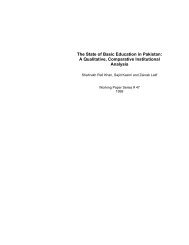
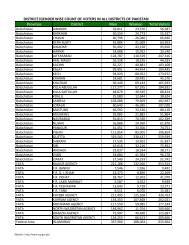
![(October - December, 2010) [13th SDC Special Bulletin]](https://img.yumpu.com/50118608/1/184x260/october-december-2010-13th-sdc-special-bulletin.jpg?quality=85)
